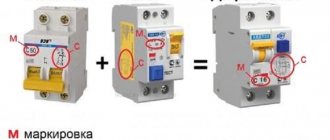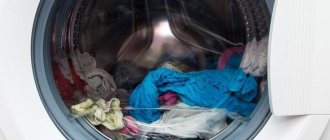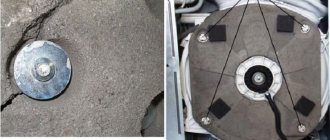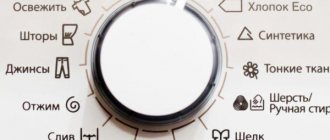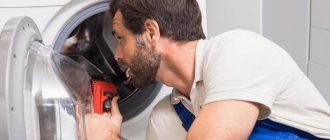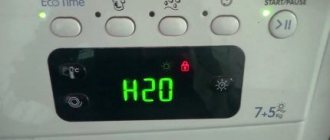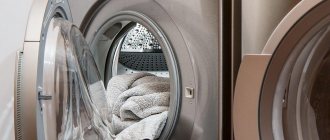If the washing machine stops during washing, there can be a variety of reasons.
Rice. 1 — Stopping the washing machine
Technical failure: one of the mechanical or electronic units has failed.
- The software froze - the “brains” malfunctioned when executing the wash cycle.
- Large load of laundry.
- Interruptions in water or electricity.
- Drain system clogged.
- Broken or loose closure of the loading hatch.
- A foreign body has entered between the tank and the drum.
Each washing machine has a marking showing how much laundry it can handle at a time. If there is a lot of laundry or it becomes excessively heavy during the washing process, the unit may not start or may stop. Therefore, the first thing to do with the machine, if it does not want to work, is to reboot, that is, turn it off for a few seconds and then turn it on again. If such manipulation does not help, a thorough diagnosis is necessary.
Why does the washing machine freeze during washing?
If restarting the washing machine did not produce results, you need to determine at what point it froze. Depending on this, it will be possible to understand why she stopped.
The washing machine does not turn on or turned off after 1 minute
If your Bosch, Indesit, Atlant or Beko does not respond to button presses or spins the drum a couple of times and does not erase further, the problems may be the following:
- in the electronic control unit,
- in a user error,
- in the hatch locking device.
If the washing machine has a display, it will display an error code. All that remains is to refer to the instruction manual, where its explanation is given.
The washing machine turns off during the washing process and beeps
The device can freeze at any time and make a sound indicating a problem, but does not display an error code.
Rice. 2 - Sudden shutdown of the washing machine
The most common reasons for a washing machine stopping in the middle of a program.
- No water supply. For example, the water in the apartment is turned off or the water supply hose is damaged.
- Uneven distribution of clothes in the drum. Sometimes things get knocked to one side, causing a lot of vibration while spinning. To avoid damage, the machine automatically turns off and the drum stops spinning.
- A foreign body has entered between the tank and the drum. Often such an object becomes a popped-out metal bra bone.
- Engine failure. With such a breakdown, the machine usually crackles and hums before turning off.
Rice. 3 - Foreign body in the machine
Each of these reasons requires an individual solution.
The washing machine turned off during the last minute of washing or while draining
First of all, you need to check whether the program is installed correctly: some modes do not involve spinning and drying. Perhaps the washing machine has completed its cycle and therefore stopped washing. You just need to wait until the hatch unlocks and you can pull out the laundry.
It's another matter if there is water left in the drum. This may indicate the following malfunctions:
- breakdown of the heating element,
- pump failure,
- damage to the drain hose,
- filter clogged.
Failures of important parts, for example, the control board, lead to the fact that the equipment can turn off at any stage of the wash.
Error codes when stopping the washing machine
A budget machine with a mechanical control without a display signals a problem by flashing the speed and rinse mode lights. But it is difficult to determine the nature of the breakdown; you have to use the method of elimination.
It is easier to determine the malfunction of an electronically controlled machine. To do this, you need to correctly decipher the error code on the display.
Each manufacturer labels errors according to its classification. There is no single system for deciphering error codes. This table uses examples of the most common mistakes to show how different brand coding is.
| Error name | ELECTROLUX and ZANUSSI | INDESIT | BOSCH and SIEMENS | WHIRLPOOL | HANSA | CANDY | SUMSUNG | LG |
| Errors when pouring water | E11, E12 | F10 | F02 | E10, FH | E02, E04, E05 | E02 | E1 | P.E. |
| The hatch is not closed (the hatch door is not sealed) | E41-E45 | F16, F17 | F01 | E40 | E01 | E01 | — | DE |
| Incorrect water drainage | E21, E22, EF1 | F05, | F03 | E20, EF0, FP | E03, E06 | E03 | E1, E2 | O.E. |
| Problems with the heating element | E66, E62, E61 | F03, F07, F08 | — | 2, 4 (buttons blinking) | — | E05 | E5, E6, E8 | HE |
| Motor faulty | E53 | F01 | E02 | 2, 3, 4 (buttons blinking) | E21, E08, E22 | — | — | C.E. |
If an error occurs, check the Operating Instructions. Only careful study of the instructions will allow you to correctly determine the cause of the problem.
Reasons for freezing during rinsing or spinning
It often happens that a shutdown occurs in the last minutes of operation in the same mode: rinsing or spinning. These two processes are similar from a technical point of view: a large amount of water is used, the drain is active, the drum rotates at maximum frequency.
The reasons for the stops in these two cases are identical.
| Situations | Solution |
| The drum is skewed due to incorrect distribution of the laundry or the laundry balance sensor has failed. In both cases, a signal is sent to the “brains” of the machine that the laundry is lying incorrectly, and it turns off to avoid strong vibration. | First, you need to try to redistribute the laundry, and if this does not help, replace the sensor. |
| Broken damper or shock absorber. During the rinsing or spinning process, shock-absorbing units experience the greatest load, dampening vibration. If an old or low-quality part breaks, the machine itself begins to slow down the process, and the rotation of the drum slows down until it stops completely. | The problem is solved by replacing the shock absorber. |
| Malfunctions in the technical sensor. Due to the high rotation speed, the sensor that controls the number of drum revolutions may fail. If this malfunction occurs, the machine automatically stops spinning or rinsing. | We correct the problem by replacing the sensor. |
| The problem is in the drainage system. A characteristic symptom: the machine freezes in the rinse or spin mode, and water remains in the drum. This can happen due to a blockage in the sewer (pipes, riser) or pipes, wear or clogging of the drain filter, damage to the drain hose, or failure of the pump. | We clean and replace worn parts. |
Rice. 4 - Faulty pump
To solve the problem, you will have to conduct a full diagnosis of the drain system. Identifying the cause of freezing during rinsing and spinning is a serious task, but removing items from a blocked washing machine is no less a problem.
If the engine breaks down
The engine is the heart of the washing machine. It is thanks to the engine that the drum of the unit moves. If this part becomes unusable, the washing machine can stop at any time. This can be not only the washing process, but also rinsing or spinning. The washing machine may fill with water and stop.
In addition, a breakdown of the motor is also indicated by the fact that the drum of the device does not rotate, although the washing machine is functioning normally. It is impossible to fix such a malfunction on your own. To do this, you need to seek help from a specialist. The service will conduct a full test of the systems and then repair all faults. As a rule, the washing machine motor is simply replaced with a new one.
How to get things out if the washing machine is frozen and won’t open?
If it hangs with a full tank of water and laundry, you need to drain the water, take out the laundry, wring it out by hand and hang it up. But how can you get things out of the car if it doesn’t open without flooding the entire floor in the bathroom or kitchen?
The algorithm for solving the problem is as follows.
- Do not turn off the automatic machine from the power supply, as this may harm it, and it is better to try a more gentle method first. Leave the washer on pause for 5-10 minutes.
- Try turning on the "drain" mode.
- If this does not help, turn off the power to the machine.
- Find an emergency drain hatch. To do this, open the plastic panel at the bottom of the washing machine. It is usually attached to hook-clips. There will be a small hatch behind the panel.
Rice. 5 — Emergency water drain hatch
- Open the hatch. For each brand of car - Samsung Diamond, Zanussi, Hotpoint, Ariston, Veko - this happens differently. For some models you will need a screwdriver, for others the cover simply snaps off.
- Place a container under the hatch. The emergency drain is equipped with a special hose. Sometimes you have to remove the filter to get to it. Use a hose to drain the water. Emergency draining of water is a lengthy procedure, since the diameter of the hose is small, and there can be a lot of water in the drum.
- Open the loading hatch by releasing the door lock with a screwdriver.
- Take out the items, rinse them, wring them out and hang them to dry.
- Close the emergency drain, try pressing the power button without loading laundry.
- If the cycle does not continue, unplug the machine, let it rest for 15–20 minutes and start another program.
- If the machine does not work or the cycle is interrupted again, you need to start diagnosing the problem.
The procedure for removing things from a frozen washing machine is not as complicated as it seems at first. It can be performed by an ordinary housewife without any special skills.
Rice. 6 — Unloading the washing machine
Simple solutions to emerging problems
During washing, household appliances sometimes stop performing subsequent actions or, in simple terms, may freeze. You cannot eliminate complex reasons for refusal, but there are also simple, sometimes ridiculously offensive ones. Here are the most common causes of simple washing machine failures.
The weight of the laundry exceeds the norm
Some models have a built-in smart sensor that is responsible for exceeding permissible limits. What to do in this case is very clear - remove excess laundry and start the machine again. If everything is normal, then you have correctly identified the cause.
Incorrect task
Sometimes users set a delicate wash, and then panic that the machine has stopped and won’t spin. There is no such function in this mode, and automation has nothing to do with it. Turn on forced drain and then spin mode.
An imbalance has occurred
When washing small and large items, an emergency situation may occur when the laundry collects in a single lump in one part of the drum. The imbalance sensor is triggered and a stop occurs. Not all users immediately understand the reason for the equipment failure, however, when opening the loading hatch, everything becomes clear: you need to evenly distribute the laundry items inside the drum and start the spin mode from the beginning.
Special sensors are installed by the manufacturer to prevent emergency situations: the appearance of unacceptable vibration due to imbalance, a large load on the electric motor when the laundry is overweight. These measures protect household appliances from overload.
Program selection error
Users sometimes make basic mistakes by choosing several washing modes at once. As a result, the washing machine stops without finishing washing. For example, the housewife chose the “Soak”, “Wash” and “Bleaching” program. Smart technology will stop in the middle of the process, because it does not have a combined “Whitening” and “Soaking” mode: they must be launched separately.
Manufacturers of modern automatic devices always very clearly describe all programs and modes, and they do not forget about the features. You should carefully study the attached instructions to avoid annoying mistakes. Household appliances wash in stages and strictly according to the programmed program, so carefully select the desired mode.
What to do and how to eliminate the causes of the breakdown?
It happens that after a reboot, changing the mode and turning off the power, the machine is not restored. There can be many reasons. Let's consider options for repairing or replacing the main parts of washing machines.
Replacing the heating element
This is one of the key parts of the washer. This element is responsible for heating the water entering inside to the temperature required for a specific washing program.
You can talk about failure of the heating element if the washing machine:
- does not heat water;
- resets the program at the beginning;
- does not work at the end of the program;
- freezes at a certain temperature, for example, 60 degrees.
You should start solving the problem by inspecting the wires leading to the heating element. If the wires are not melted, then the problem is in the heater itself. And it needs to be repaired or replaced.
On various machines, access to the heating element can be through the back of the case or through the front panel. Where the removable surface is larger is where the approach to the heater is located. The location of the heater at the rear is typical for machines from brands such as Zanussi, Candy, Hotpoint Ariston, Indesit, Ardo and Electrolux. And manufacturers Bosch and Samsung most often place heating elements in the front. To access the heater on top-loading models, one of the side walls must be removed.
Next you need to perform the following steps.
- Before removing the heating element, it is necessary to drain the water and disconnect the machine from the network.
- Disconnect the wires going to the heating element. Unscrew the nut that is located in the middle, and then drive the pin connecting to the nut inside. To do this, press it hard or tap it with a hammer.
- Remove the heating element from the tank and check the functionality of the part using a multimeter.
Rice. 7 — Replacing the heating element
- Insert the repaired or new heater into place. Repeat the steps in reverse order.
- Run a test wash by selecting a program that provides maximum water heating.
Even a non-professional can cope with replacing the heating element in a washing machine.
Replacing the heating element
The heating element cannot be repaired. It needs to be replaced. To do this, you need to drain the water, turn off the power, remove the cover located on the back of the washing machine, and disconnect the sensors, grounding and power cord. The nut on the screw should be loosened. To do this, you need to make about 6 turns and then press in the screw. After completing these steps, you can easily remove the heating element.
When choosing a new heating element, you should pay special attention to the markings. Each model requires its own heating element. The heating element should fit into the grooves evenly and without distortions. Hardware should be tightened with force. However, you should not overtighten them. To complete the installation, all wires must be connected. Then you need to replace the device cover and run a test program at high temperature. If the device does not freeze and works normally, then the problem is resolved.
Recommendations for the selection and operation of equipment
A washing machine can last 10 years or more if handled properly.
- When purchasing, you must take into account the warranty and service life. If it is guaranteed that it can be used for five years without breakdowns, then this should alert the buyer, since the warranty is given for the same period. That is, after this time has passed, the machine will completely stop working.
- If the power of the machine is quite high, then even under such positive circumstances the drum should not be overloaded. The power must clearly correspond to the operating parameters. If the load is within normal limits, but the machine turns off, then this indicates that the power indicator was not originally designed for such a volume.
- It is better to prepare the washing unit for connection earlier. When calculating the work of an electrician to turn on a microwave or kettle, the machine will never start the drum. In this case, her efforts will only be enough to turn it on. To ensure power supply, it is necessary to install a distribution panel. It is recommended to separate the electricity supply from living areas and bathrooms.
- Check the connection of the pipes to the water supply before purchasing; they must be closely adjacent to avoid leaks. If in doubt, it is better to call a specialist.
- Everything else depends on the configuration of the washing unit. The technical device must be carefully inspected before purchase.
Models with an average power rating are most preferable. It is also important to take into account that not all units from foreign manufacturers will fit Russian standards and can be installed in residential premises without problems; many of them will require special connectors and grounding conductors. In this regard, it is necessary to carefully analyze which technique to choose so that unnecessary problems do not arise.
